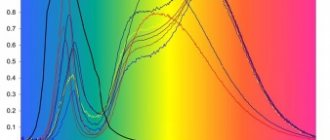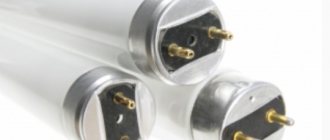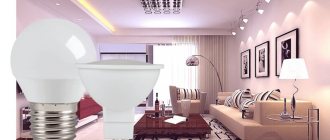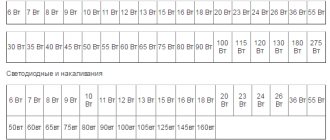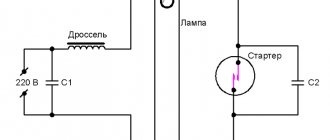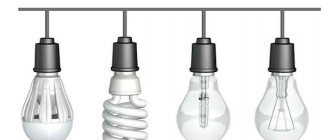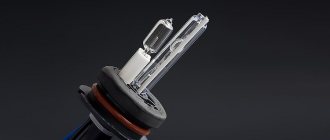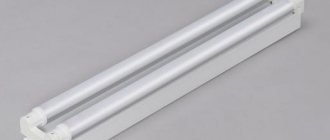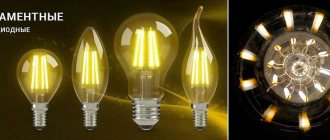What needs to be changed?
By carefully looking at the diagrams, even an inexperienced electrician will understand how to connect an LED lamp instead of a fluorescent one. In a luminaire with ballasts, you need to perform the following steps:
- Turn off the circuit breaker and make sure there is no voltage.
- Remove the protective cover, gaining access to the circuit elements.
- Remove the capacitor, inductor, and starter from the electrical circuit.
- Separate the wires going to the cartridge terminals and connect them directly to the phase and neutral wires.
- The remaining wires can be removed or insulated.
- Insert a T8 G13 lamp with LEDs and perform a test run.
Converting a fluorescent lamp with electronic ballast is even easier. To do this, just unsolder or cut with wire cutters the wires going to and from the ballast. Then connect the phase and neutral wires to the wires of the left and right sockets of the lamp. Insulate the connection point, insert an LED lamp and apply supply voltage.
It is much easier to install and connect a T8 LED lamp in Philips branded lamps. The Dutch company has made the task as simple as possible for its consumers. To install an LED lamp with a length of 600 mm, 900 mm, 1200 mm or 1500 mm, you will need to unscrew the starter and screw in the plug supplied in the kit in its place. In this case, there is no need to disassemble the lamp body and remove the choke.
When choosing a T8 G13 LED lamp, you should pay attention to the design of the base. It can be rotary or have a rigid connection to the body. Models with a rotating base are considered to be the most universal.
They can be screwed into any converted light fixture, with either vertical or horizontal slots in the socket. And by adjusting the angle of the lamp, you can change the direction of the light flux
Models with a rotating base are considered to be the most universal. They can be screwed into any converted light fixture, with either vertical or horizontal slots in the socket. And by adjusting the angle of the lamp, you can change the direction of the light flux.
Connection diagram
LED lamps are installed in existing housings without requiring their replacement. You just need to change the connection diagram and remove unnecessary devices that are necessary for the operation of fluorescent lamps, but useless for LED devices. These include ballasts (ballast control equipment), which includes a starter and a choke with a capacitor. If it doesn't interfere, the ballast can be left in place, although most users prefer to get rid of all unnecessary devices.
Important! The connection diagram for a T8 LED lamp instead of a fluorescent analogue is simple - you need to apply a phase to one end of the lamp and zero to the other. If there are several devices, they are connected in parallel. There are pairs of contacts at the ends. When connecting fluorescent lamps, a zero and a phase are supplied to each pair.
After changing the circuit, it will no longer matter which contact of the pair the wire is connected to, since they are connected inside the housing. Procedure:
- turn off the power to the lighting device, it is best to turn off the circuit breaker at the switchboard;
- remove the lamp from the ceiling or walls, remove it from the suspended ceiling (depending on the installation method);
- remove old fluorescent lamps in the usual way;
- disconnect the wires leading to the starter;
- dismantle the chokes, since they will no longer be needed;
- disconnect the cartridges and make jumpers on them;
- connect each cartridge directly and install it in place;
- check that the connection is correct, and then install the LED lamps;
- turn on the lamp, make sure the connection is normal and working. If errors are detected, immediately disable it and correct everything;
- Place the lamp in place.
Which is better: LED vs fluorescent
When compared with other lamps, LED lamps greatly benefit in terms of efficiency. However, replacing fluorescent tubes with them is associated with a number of problems. You cannot simply insert an LED into a lamp in place of a gas-discharge bulb.
Before installing T8 LED tubes in a luminaire originally designed to connect fluorescent lights, it is necessary to remove the starter. If the LED lamp has a built-in driver, then it only needs direct power from a 220 V network.
But the circuit also contains ballast (choke). Some tubes with LEDs are compatible with it. They may well work without removing this element. In this case, you only need to unscrew the starter. However, there are modifications of LED lamps that do not need a ballast load at all and are even contraindicated. It also needs to be removed by connecting the wires at the site of the gap.
Such alterations lead to the fact that after putting the fluorescent tube back it becomes impossible. However, usually no marks are made on the lamp body about these modifications to the power circuit. As a result, a new electrician comes in and for one reason or another inserts a fluorescent light. And this is a direct path to problems in the electrical network.
Plus, measurements show that T8 LED lamps connected via ballast can lose up to 20% energy efficiency. This is additional wasted electricity. Moreover, a lot depends on the manufacturer. Some reduce these losses to almost zero, increasing the cost of the product, while others simply do not mention them on the packaging.
It is best to initially choose a tube designed for direct connection. Then you will only need to remove everything unnecessary from the lamp and make notes on the lighting fixture about the changes made. This is a more difficult solution to install, but not so problematic in the future.
In general, replacing T8 fluorescent lights with LED lamps of similar sizes has a number of advantages:
- Energy savings, consumption is reduced by 50-80%.
- Longer service life (manufacturers claim 5–6 years of continuous operation, but practice speaks of 3–4 years).
- No flickering effect.
- No dangerous mercury vapor.
- Higher light output.
Almost all models of T8 LED tubes have a narrow luminous flux of 180 degrees. The luminescent opponent, on the contrary, shines in all directions, losing most of the light that is directed upward directly into the body of the ceiling light fixture.
Long service life
The lifespan of an LED lamp is up to 35 times longer than that of a conventional incandescent lamp. Before it begins to gradually fade, it will faithfully serve you for about 80 thousand hours (that’s a little less than ten years). After this, the brightness will decrease by a third. Of course, the operating time of an LED is directly related to its quality, the thermal design of the lamp and the power circuit. Typically, manufacturers and their representatives have a table of LED degradation. Ask for it before purchasing so you have an idea of how long they will last in a particular design.
Classification
Incandescent lamps
In the recent past, the most common type. Lighting devices of this type can be used on both stationary and portable devices (for example, hand-held flashlights).
Light is emitted by a heated tungsten filament placed in a flask (balloon) from which air has been evacuated (hence the term “vacuum”).
Based on the composition of the gas in the cylinder, incandescent lamps are divided into vacuum lamps, krypton lamps, and halogen lamps.
Vacuum
The surface of the bulb can be either transparent or matte, which allows you to get softer light without using a protective cap. Also, the top of the cylinder can be coated with mirror paint to direct the light flux downwards (for ceiling lighting).
Lamps for portable sources operate on voltages of 12, 24, 36 V.
For stationary ones - 220 V, 50 Hz (city electrical network).
The main disadvantage of such light sources is low efficiency: only 2-3% goes to lighting. The rest of the energy is dissipated as heat (hence the low luminous efficiency).
The type of fastening used is Edison base (E-base); differs in its diameter (in mm), indicated in the marking:
- E10 – used for flashlights;
- E14, also called "minyon" (small);
- E27 – standard;
- E40 is used for outdoor lighting;
Pros:
- widespread use of equipment;
- low price;
- ease of installation;
Minuses:
- low efficiency;
- short operating time (500–1000 hours);
- fire hazard (cannot be used in plastic and wooden structures);
Characteristics:
| Base | E |
| Power | 5 – 500 W |
| Luminous output | 7–17 lm/W |
| Color rendering Ra | more than 90 |
| Light temperature | 2700 K |
| Price | from 10 rub. |
| Life time | 500–1000 hours |
Krypton lamps
An incandescent lamp with krypton (an inert gas) added to its cylinder. They have smaller dimensions and longer operating time compared to vacuum ones (1000–2000 hours), and are not sensitive to voltage changes.
Characteristics:
| Base | E |
| Power | 5 – 500 W |
| Luminous output | 8–19 lm/W |
| Color rendering Ra | more than 90 |
| Light temperature | 2700 K |
| Price | from 40 rub. |
| Life time | 1000–2000 hours |
Halogen lamps
As the name suggests, the flask contains pairs of halogens (elements of group 17 of the periodic table - bromine or iodine). The addition of these gases allows you to significantly increase operating time and increase light output compared to vacuum analogues.
An E- or G-base is used (see fluorescent lamps).
Pros:
- Service life up to 2000-4000 hours.
- Small size, suitable for use in plasterboard structures (for example, suspended ceilings).
Minuses:
- Sensitivity to contamination (installation must be done with gloves; if grease gets on the surface of the flask, the device quickly fails).
- Sensitivity to voltage changes.
Currently, a new type of halogen sources with an infrared coating has been developed, which transmits visible light and reflects thermal radiation; they have reduced energy consumption and increased operating time compared to their uncoated counterparts.
Characteristics:
| Base | E, G |
| Power | 20 – 1500 W |
| Luminous output | 14–30 lm/W |
| Color rendering Ra | more than 90 |
| Light temperature | 3700 K |
| Price | from 20 |
| Life time | 2000–4000 h. |
Benefits of replacing with LED
Let's calculate how profitable it is to install new diodes instead of fluorescent ones. We take into account that they are placed on an Armstrong suspended ceiling and shine in all directions. Due to the limited dimensions of the body itself, the body of the tube obscures its reflected light. The calculation was made by an electrician, he has more extensive experience in this.
Let's carry out a simple calculation for gas-discharge systems, which will involve:
- Efficiency of all luminescent from 70%
- shading coefficient of light flux when reflected from a mirror reflector, 0.6-0.7;
- light source efficiency 50-60 Lm/W;
- service life no more than 18,000 hours.
For diodes, these values will be respectively:
- 90% efficiency depends on the power supply;
- 0.9 because it only shines down;
- 100-120 Lm/W for the middle price category;
- up to 50,000 hours, after this period the brightness will decrease to 70% of the original.
Using the above coefficients, you can make your own calculations. A diode light source is 2 times more efficient and economical only in terms of electrical parameters. If we take into account the service life, then in the end the superiority of new technologies will be 4 times.
LED lamp life
Depending on the type of lamp and manufacturer, the product life is from 20,000 to 50,000 hours of operation. That is, a high-quality lighting source can last more than 5 years if used daily.
Usually information about the service life is indicated on the packaging, but you can’t always believe what they write. For example, manufacturers often indicate an impressive service life, although the products are cheap. It is unlikely that an inexpensive light bulb will last as long as possible.
Even if the manufacturer did not cheat with the resource, it is worth considering external factors that may affect the service life. These are: power surges, power surges, poor-quality electrical wiring, damage to the lamp. If LED sources are located outdoors, their operation is negatively affected by adverse weather conditions. Undesirable factors can reduce the lamp life by about a third.
It is impossible to predict in advance how long a particular lamp will last. However, there are ways to extend the life of diode light sources:
- Using a dimmer. A device with a switch lever is used to adjust the brightness of the light. The dimmer suppresses inrush current, which is often the main cause of premature lamp burnout.
- Organize “smart lighting”. Automatic switching on and off of lamps upon command or sensor signal will avoid unnecessary manipulations.
- Buy a quality lamp. A well-designed device is an important factor for the correct operation of the lamp.
If LED strips are used for illumination, it is better to stick them on aluminum surfaces. The material absorbs part of the thermal energy, so the lighting device will not fail as a result of overheating.
Review of LED tube manufacturers
In recent years, the LED technology market has been booming. The number of brands and manufacturers is growing exponentially.
This leads to a gradual reduction in LED prices in stores. However, these processes are not always beneficial for the average buyer, since there is a high risk of running into a frankly low-quality product.
Most LED tubes are made in China - if it is a well-known brand, then there is nothing wrong with that, but you should not buy products from an unknown manufacturer from China
Among the numerous manufacturers of T8 LED lamps, the following are well-deserved trust:
- From the European-world ones - “Gauss”, “Osram” and “Philips”.
- Among the Russian ones are “Optogan”, “Navigator” and “SVeto-Led” (“Newera”).
- Among the proven Chinese ones are “Selecta” and “Camelion”.
The price of LED tubes for ceiling lights largely depends on the region and the specific seller. Plus, the characteristics of the model also play a significant role.
Before you buy this or that option, you need to carefully study the labels on the packaging.
You will learn what to do with an old fluorescent device after replacing it in the following article on the disposal of devices containing mercury.
LED lamps instead of fluorescent lamps: is it worth changing?
Replacing Armstrong lamps with LED ones is in most cases justified, since LED sources are superior to their outdated counterparts in almost all parameters. For yourself, calculate the initial expenses, compare the parameters of different light bulbs, recalculate the savings in the long term if LED lamps replace 18 W fluorescent lamps.
T8 fluorescent lamps:
- produce up to 10,000 hours, usually less;
- light is distributed in different directions and requires special reflectors;
- increase brightness when turned on incrementally;
- The circuit breaker often malfunctions;
- the luminescent surface layer gradually loses its qualities, the light flux decreases by a third quite quickly;
- mercury, the flask must be properly disposed of.
LED lamps T8:
- last up to 50 thousand hours (take into account the number of on-off switches);
- give directional light;
- immediately turn on brightly with full luminous flux output;
- there is no need to install drivers or chokes and starters;
- brightness is lost no more than 10% for every ten thousand hours;
- energy consumption from the network is minimal;
- environmental safety – 100%.
The light output of T8 LED lamps (with the same energy consumption as fluorescent lamps) is many times greater, and they very rarely fail ahead of schedule. When purchasing, you receive a warranty from the manufacturer or supplier. The ability to place a different number of LED elements inside the main bulb allows you to obtain any light intensity and any color temperature. Having weighed the strengths and weaknesses of the solution, we can say that LED lamps instead of fluorescent ones will be more profitable in the future. There is only one drawback - LEDs are more expensive.
Specifications
Using the example of the Eurolamp LED NANO T8 9W 6500K model, you can familiarize yourself with the standard characteristics and parameters of the luminaire. Many parameters are the same as the standard characteristics of other LED lamps, such as the Gauss LED lamp. However, specifications may vary depending on the model and manufacturer.
- Lamp shape – linear
- Power consumption – 9 W
- Operating voltage – 220-240 V
- Color temperature – 6500 K (bluish white). There are also models with color temperatures of 2800 K (warm white) and 4000 K (neutral white).
- LED lamp base T8 – G13.
- Brightness reaches 880 lm.
- The color and type of the bulb is matte opaque (transparent and translucent are also available).
- The equivalent power of an incandescent lamp is 90 W.
- Dimensions – 600×30 mm.
- Service life up to 50,000 hours.
Technical characteristics of T8 LED lamps
Before you begin to consider the parameters of T8 LED lamps, you need to understand that fluorescent and LED lamps are created using completely different technologies and each operate on its own principle. They are united only by the same shape and method of installation in the socket of the lighting device. All other parameters correspond to the design features of each type of device and have little connection with each other.
The parameters of these devices are difficult to compare with each other, but in terms of general characteristics it is quite possible to make some comparisons. Typically, users are of little interest in specific data; it is enough for them to know the basic characteristics.
T8 LED lamps have the following technical indicators:
Attention! The technical characteristics of T8 LED lamps are constantly being improved and supplemented by manufacturers. Developers are making every effort to increase the useful properties of devices, reduce disadvantages and make their products accessible to the mass buyer.
Main advantages of LED
Linear LED lamps are an innovative element in industrial, commercial and public lighting systems due to insufficient awareness of the population about the main advantages of this type of lighting technology.
Key characteristics are as follows:
- Connection to a 220 V network directly without the use of ballasts and chokes.
- Low energy consumption, which allows significant savings.
- Wide dispersion angle – up to 230°.
- Depending on the manufacturer, the service life is 50,000-100,000 hours.
- The environmental friendliness of diodes does not cause harm to the environment; they are disposed of together with household waste.
- Complete absence of flicker.
- Does not heat up during prolonged use.
Also, the design features of the housing make it possible to achieve resistance to the influence of negative factors: temperature changes, moisture and stress, and mechanical stress. And due to the high color rendering coefficient and brightness level of 120 lm/W, correct visualization of surrounding objects is achieved.
LED devices provide uniform dispersion of light fluxes throughout their entire operational life, without the effect of rattling noise. These lamps do not emit heat
Elimination of the pulsation effect became possible thanks to the equipment with special elements - amplifier lenses and light diodes, which are responsible for compaction and concentration of the light flux.
In addition to natural monochrome cold and warm white lighting tones, manufacturers also offer various color effects (RGB design), which are mostly used for decorative purposes by entertainment venues or for illuminating advertising billboards.
The main problems accompanying the mass introduction of this technology are the high price category and the lack of government control over the quality characteristics of products presented in stores. About 50% of lighting devices do not comply with current GOST standards.
Main advantages
T8 LED lamps are significantly superior to alternative models in almost all respects. The advantages of the devices include:
- efficiency, high luminous flux values;
- efficiency;
- long service life;
- the lighting is directional, which allows you to organize a more efficient and comfortable lighting mode;
- connection occurs instantly, which is not observed with fluorescent lamps;
- smooth, flicker-free operating mode;
- it is possible to work when the voltage in the network is unstable;
- do not create electromagnetic interference;
- no harmful radiation in the ultraviolet range;
- the ingress of fat particles or other suspended matter in the air does not create the danger of overheating and explosion of the lamp, which are characteristic of alternative designs;
- recycling of LED devices does not require specialized measures and can be done in the usual way;
- Such lamps can be connected directly to a 220 V network, without intermediate devices.
Types of lighting products
Ice lighting device T8 marked base g13 is not divided into any special types. The only differences between the lamps are:
- tube length and size;
- power supply of light fluxes;
- brightness of light when emitting.
The light output varies over a larger width range. This allows you to use several different lamps in tandem. Different lighting powers can divide a room into separate zones, hide shortcomings and highlight advantages. The power of the light streams varies from 9W to 36W.
You can also choose the temperature when heating the lamp yourself
It is important to remember that at high temperatures the lamp emits brighter light, and at lower temperatures, on the contrary, it dims. The use of low-temperature lamps is recommended for use in utility rooms (corridor, storeroom, elevator)
Minuses
But is everything so perfect in the field of LED lighting? Although ideal at first glance, this option still has certain disadvantages. The disadvantages include their high cost. Despite the assurances of manufacturers that this practice will soon fully pay for itself due to savings in the future, it is incredibly expensive to make all the lighting in the apartment LED. We are talking about any form of light source. Chandeliers, lamps, duralight, ribbons and decorative lanterns, powered by a power supply or from the mains, provide light thanks to LEDs, the cost of which is high due to the complexity of technological production.
Another significant disadvantage of LED lighting is the lack of training of specialists to work with it. Many electricians and power engineers are just getting acquainted with such equipment, and it is too early to talk about their professionalism in this area. Equipment installed unprofessionally may fail. And this is very deplorable, considering its cost.
Everyone decides for themselves what lighting to choose for their home. But the fact remains indisputable that when making a determination, a number of points should be taken into account, which in the future can significantly harm health, property and well-being!
Types of T8 lamps
Types of flask
T8 lamps, also marked G13, are also called T8 LED tubes. Externally, this is also a tube made of matte or transparent polycarbonate, but the filling consists of LEDs. The dimensions fully correspond to luminescent ones, standard sizes are 600 mm, 900 mm, 1200 mm.
Structurally, they are of two types:
- the driver is installed inside the tube under the LED diodes, accordingly, it is powered by a voltage of 220V;
- An external driver is used, like from an LED strip, powered by a voltage of 12V.
Built-in drivers for 220 volt models
According to their design, flasks are divided into 3 types:
- transparent, 0% loss;
- translucent, satin, loss 10%;
- matte, not transparent, light loss on average 20%.
The flask is made of acrylic plastic or polycarbonate, which gives good mechanical strength.
Standard sizes:
- 300mm. for desktop;
- 600mm. for Armstrong ceiling lamps;
- 900mm.;
- 1200mm.
The luminous flux increases in proportion to the length, the length has increased 2 times, it shines 2 times brighter.
Colorful temperature
The color temperature has the same characteristics as LED lamps:
- warm white light;
- neutral white, daytime;
- cold, bluish compared to warm.
Of these options, the best one is neutral daylight, the eyes perceive it best, a white sheet of paper will be really white and will not turn yellow as if it were warm.
Main types of lamps
Standard sizes of LED lamps are 600 mm, 900 mm, 1200 mm.
According to their design characteristics, they are divided into two types:
Flasks are divided into the following types:
When making flasks use:
These materials are durable and reliable in use.
The luminous flux and power consumption increases depending on the length of the light source and is approximately (may vary among different manufacturers):
Color temperature varies depending on the type of lamp:
Of all the types, neutral white light is the best option. This light is great for the eyes. Your eyes will not get tired, and the light will shine brightly. However, for rooms where it is necessary to create a homely atmosphere of comfort (kitchen, bedroom), warm white light will be more acceptable.
MANUFACTURER
The high cost of LED lamps makes us especially attentive to manufacturing companies: you should buy such products only from well-known companies that guarantee the quality and long-term operation of their devices. The most reliable today are Osram Opto Semiconductors (Germany), Nichia (Japan), Seoul Semiconductors (Korea), Philips-Lumileds and CREE (USA). It is better not to buy cheap Chinese products: their LEDs contain a material with low reliability - sapphire. German and American LEDs use the best silicon carbide technology.
Without a doubt, the mentioned manufacturers are worth their money, but trends change from year to year - the opinion, as they say, is subjective. The Chinese also fly into space, and the domestic industry does not stand still.
Types and characteristics of lamps
There are two classes of T8 standard tubular products on the domestic market. These are fluorescent and LED light bulb samples. Despite the apparent similarity of different types of tubes, their operating principles are fundamentally different.
T8 fluorescent lamps
Fluorescent lamp OSRAM T8 NATURA L30W/76 G13
This type of lighting fixture is the most common example of a group called “fluorescent lamps” or LDS. Their flask is filled with mercury vapor, which, when a glow discharge is ignited, emits ultraviolet radiation close to a blue glow. It affects the phosphor, which is applied to the inside of the flask during manufacture. As a result, the coating begins to glow, and the part of the UV spectrum that is harmful to the eyes is absorbed in the body of the glass tube.
To start and maintain combustion, two spiral-shaped electrodes are used, the voltage to which is supplied through the G13 connectors at the ends of the tube. To control the flow of the discharge in the bulb, which should not turn into an uncontrolled arc process, the current through the gap is limited by taking special measures. For this, an electronic or electromagnetic electronic ballast control device (the so-called “ballast”) is used, which at the same time ensures easy starting of the light bulb. This working unit, built directly into the lamp, is designed to work with two tubes of 18 W each at once.
LED lamps T8
LED lamp T8
In contrast to LLs, tubular LED fluorescent lamps do not use mercury and phosphor; the radiation is generated by semiconductor LEDs placed inside the bulb. Their total number is determined by the requirements for obtaining the required light output (radiation power), and also depends on the dimensions of the lamp. There are two types of LED illuminators with a standard size of T8:
- Models with built-in driver.
- Products that can work without it.
The former do not require additional devices, which allows them to be connected directly to a 220 Volt network. The second type does not contain a built-in driver, so they require a separate power supply to operate. With its help, it is possible to convert alternating 220 Volts into a voltage suitable for powering LEDs.
Main characteristics of household LED lamps.
Main characteristics of household LED lamps
In order to evaluate the advantages of LED lamps, it is enough to simply compare them with traditional incandescent lamps. First of all, the motivation for switching to LED lighting is the opportunity to save energy consumption and, accordingly, lower light bills. In addition, LEDs have a number of other advantages that will delight consumers.
LED lamps do not require preheating, meaning they are instantly capable of generating the brightest light possible. The maximum temperature to which an LED lamp can heat up is 45 degrees above zero.
Another undeniable advantage is the long service life. Thus, LED lamps in average operation mode can operate for 50,000 hours, which is equivalent to 3 years of continuous operation. If you use the device for 8 hours daily, its service life will be more than 9 years.
A common problem faced by apartment residents and owners of country houses and country houses is voltage surges . Changes negatively affect most lighting fixtures and can completely damage them. For LED lamps this is not a problem, since in the event of a voltage drop they maintain the initial level of illumination and brightness.
For household use, LED lamps with a matte and transparent spherical bulb, with a bulb resembling a candle flame, as well as lamps resembling the shape of a mushroom are most suitable. It is important to understand that all these characteristics will manifest themselves effectively only if LED lighting devices are used correctly.
Application area
Apartment
Led is installed in ceiling, wall, and decorative lamps. LED strips are widely used for illuminating cabinets, niches, ceilings, and furniture. We sell one-piece LED lamps and models with a replaceable lamp. Also, due to the unification, LEDs are suitable for most existing chandeliers, sconces and floor lamps.
LED apartment lighting
Office
For offices and industrial buildings, built-in or surface-mounted LED ceiling lights are used. They are often mounted in suspended ceilings (PVC or Armstrong type). LED models provide uniform diffused light, do not hum, and instantly exceed operating power.
More about office lighting
led office lighting
Trade
Sales directly depend on lighting in stores. The main goal of the light: to present the product in the desired favorable perspective. For this purpose, LED track, modular, cardan, spotlight models, as well as downlights are used. The task of the lamps is to create a directional luminous flux to highlight the product.
Trade lighting
Industrial
In industry they are used not only in offices and offices. LED lighting with the required degree of protection is used for production workshops, warehouses, farms, and greenhouses. LED models are good because they can withstand harsh operating conditions: high humidity, different temperatures, dust, dirt.
Industrial LED lighting
Emergency
Used when the main lighting is turned off. It is used in industry, medical, entertainment institutions, shopping centers. LED emergency luminaires can be completely autonomous or connected to a separate emergency power line.
Console (street)
Illuminates highways, city roads, streets, parks, pedestrian paths. LEDs are also used to illuminate the facades of historical buildings, sculptures, and shopping centers. It is used to broadcast advertising on billboards and screens, to create light installations and paintings.
Road lighting
Spotlight
Floodlights are equipped with LEDs to illuminate stadiums, train stations, airports and other large public areas.
Cons of LED lamps
However, no matter how many advantages LED lamps have, they still have several disadvantages:
- Gradual degradation of crystals and a stable deterioration in brightness, which is typical for cheap Chinese products or with an improper design cooling system.
- The need to select color temperature. Cool colors often reduce the feeling of comfort in a living space and can cause visual irritation.
- Flickering resulting from improper operation or initially poor quality of the lamp.
- High price. The more popular the brand, the more expensive the product. In addition, the more complex and powerful the lamp, the more advanced the radiator and related equipment must be, which also leads to higher prices.
If the selection rules are followed and operating conditions are met, LED lamps have more advantages than disadvantages and fully pay for the costs.
SunLike LEDs - differences and features
And finally the day has come when LED light bulbs with solar spectrum appeared on the market in the affordable segment.
They are made on the basis of SunLike LEDs (like the sun).
How are they different from all the others? Conventional LED lamps use crystals that emit blue light.
And only by filling it with phosphor does this light become white. How?
The phosphor used is not a simple one, but a two-component one. Passing through it, part of the spectrum turns green and the other turns red.
The blue color passes through the phosphor without any changes.
In Sunlike:
Firstly, a three-component phosphor is used
Secondly, the original crystal emission light is violet, not blue
As a result, we get an even spectrum of red, blue and green components at the output.
Such light bulbs no longer have characteristic peaks or dips of a certain color.
Instructions for replacing fluorescent tubes
When replacing fluorescent tubes with LED devices, the work can be done in two ways: installing LED light sources equipped with similar contacts (G13) and the same geometric dimensions, or installing LED boards with lenses into the lamp housing.
The work is carried out in the same sequence, but with some differences in the nature of their implementation.
Reconstruction is performed in the following sequence:
- Before starting work, the lamp is turned off; for this it is not enough to simply turn off the switch, but it is necessary to turn off the power to the entire group line in the lighting panel (circuit breaker);
- Work is carried out using serviceable tools, and when working at height, serviceable stepladders or scaffolding.
- The personnel performing the work must be dressed in special clothing and have personal protective equipment: gloves, helmets, mounting belts - when working at height.
- When the group line is disconnected, a prohibitory poster “Do not turn on, people are working” is hung on the circuit breaker.
- After completing the preparatory work, the fluorescent lamps and starters are removed from the lamp body. The lamps are handed over to the responsible person for further disposal.
- The contact connection is reconnected, eliminating the use of the choke installed in the luminaire. The connection sockets are connected directly to the terminal block, which is supplied with power from the group line.
- When installing a tubular LED lamp, it is mounted using a pin connection. The pins are inserted into the connector, after which the lamp is rotated around its axis until the pins enter the contact connection sockets. The performance of the lamp is checked.
- When installing a board with lenses, they are also connected to the terminal block. Their fastening in the luminaire body is carried out using magnets supplied with the boards, or using self-tapping screws that secure the boards through the holes provided in their case. After installation and connection, a functionality check is performed.
- After completion of the work, the premises are cleaned and prohibitory posters are removed.
Temperature and service life
LED crystals are small, but emit a fairly intense luminous flux. In this case, part of the energy goes into heat. Its removal is carried out through aluminum radiators. If the product is handmade, this will significantly reduce its service life. The same effect is created by the lack of the required amount of thermal paste. Note that at low temperatures these features do not manifest themselves.
Fluorescent tubes are less resistant to frost. At temperatures closer to zero, they have to spend quite a lot of time reaching operating temperature. Without this, the device cannot reach the nominal brightness level. Under conditions of high humidity, a film forms on the fluorescent tube, reducing the surface resistance. This in turn affects the ignition voltage of the device.
In general, if you value durability, then replacing fluorescent lamps with LED lamps will be relevant for you. The service life of the latter ranges from fifty to one hundred thousand hours. Note that energy-saving light bulbs have a safety margin that is almost 5–10 times less.
Of course, when we talk about service life, we mean high-quality products from branded manufacturers that provide an appropriate guarantee. Cheap fakes from unknown manufacturers, both LED and fluorescent, will last a year or two at most.
Advantages of LED lamps
LED lamps have a number of advantages:
- Economical lamps based on such lamps consume a small amount of electricity.
- They are the most durable and last 20 times longer than conventional light bulbs.
- They hardly heat up, so it’s convenient to change and safe for children.
- The brightness of such lamps does not change depending on the voltage level and over time.
- Bright lamps are installed safely in chandeliers with power limitation.
- The luminous flux and color are as close to natural as possible.
- This is an environmentally friendly analogue of other lamps, as it does not contain substances hazardous to human life and health.
- The LED lamp immediately turns on at full power. Does not require time to warm up, like fluorescent lamps.
Rules for using LEDs.
Rules for using LEDs
is nothing complicated about replacing a traditional lamp with an LED one To do this, you need to unscrew the old light bulb from the lamp socket and screw a new one into it. It would seem that even a schoolchild knows this, but for proper operation of the LED it is worth considering some factors:
- The base of the old lamp and the new one must be the same;
- The power consumption of a new light bulb should be 6 or 8 times less;
- The LED lamp should have a warm color tone;
- Color temperature should not exceed 3,000 K;
- The color rendering index must be at least 80;
- Light dispersion angle – more than 300 degrees; for spotlights and table lamps - less than 180 degrees;
- The light pulsation coefficient should not exceed 10%.
In addition, most LED lamps will not work well in combination with dimmers (brightness controls) and backlit switches.
In order to improve color rendering, it is best to choose LED lamps so that their light emphasizes the colors of the interior. Universal in this matter are LED lamps that emit neutral white light (4,000 K). For cool shades of the interior, lamps with an indicator above 4,500 K are more suitable, and for pastel colors - no higher than 3,000 K.
In chandeliers and sconces, it is best to use lamps with a matte finish, so that the light is not too bright. Otherwise, everything depends on the personal preferences and needs of the consumer.
